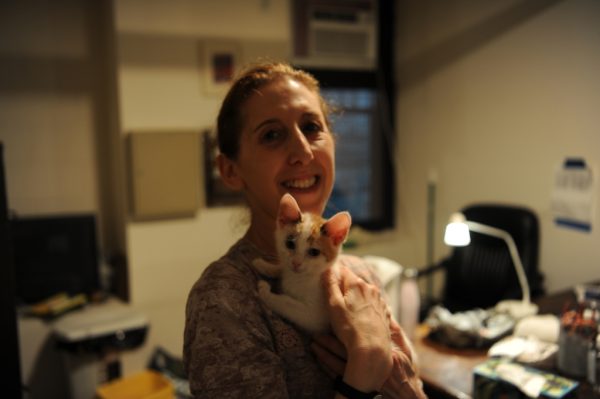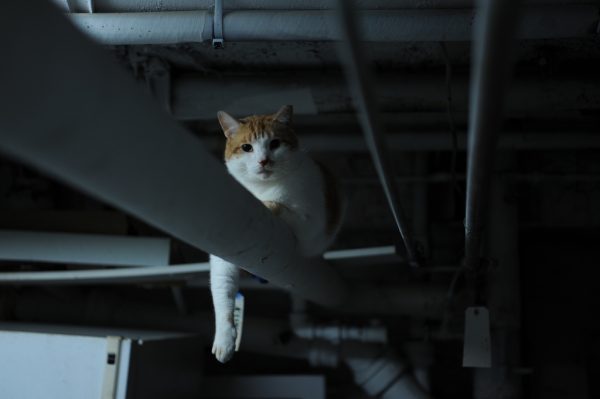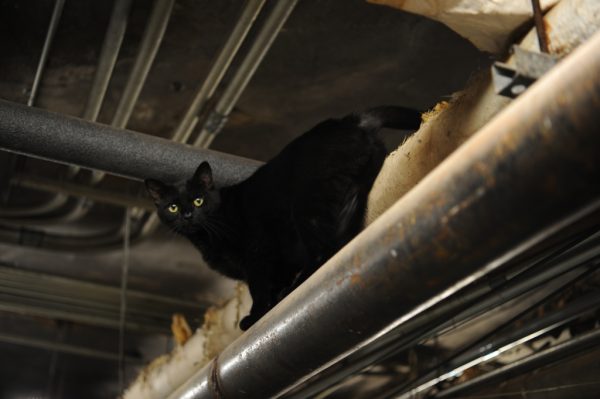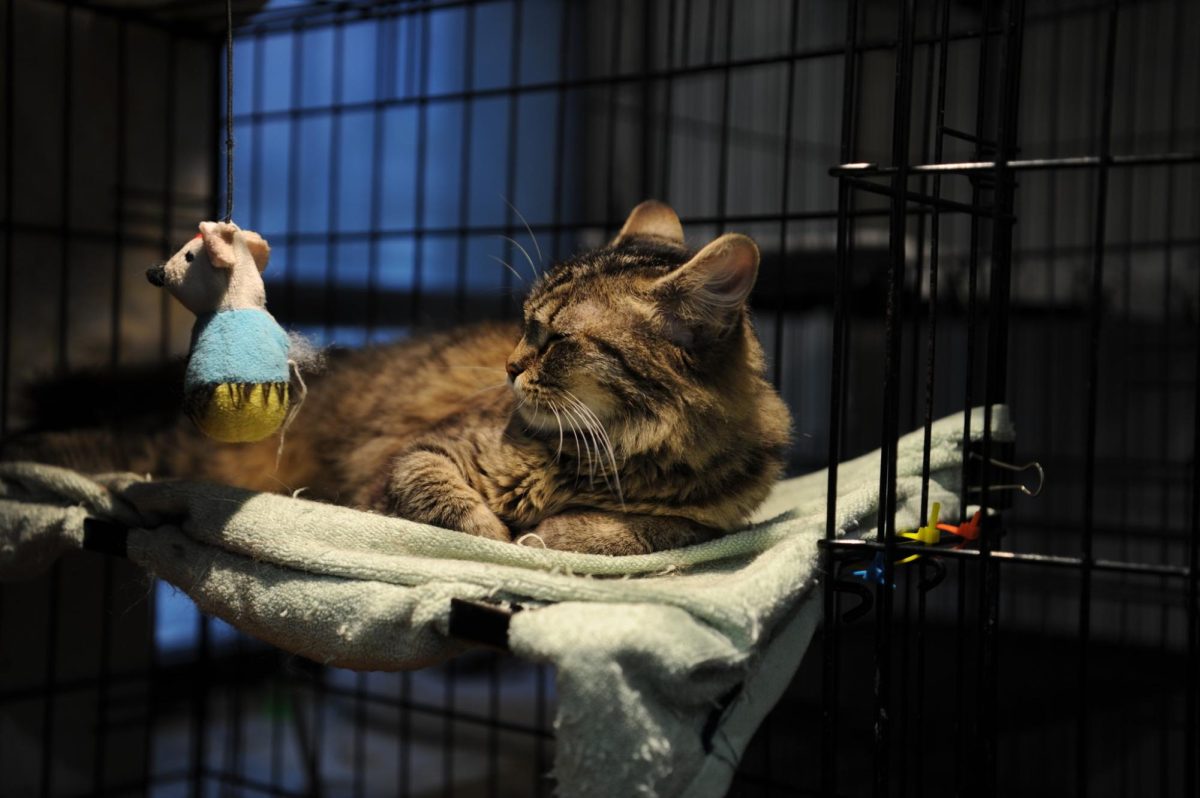720 West 181st looks like any other apartment building in Washington Heights, Manhattan. But a quick look into its basement proves that it’s anything but normal. Past the low-hung pipes and the crumbling walls lies a three-room office, filled to the brim with food, litter, and cats.
The more sociable cats will be patrolling their room, free from their cages. The newcomers will be inside of theirs, usually fearful of their new surroundings. But all of them will eventually be adopted into their ‘forever home’.
Hidden below ground, this shelter is a rare gem in the heart of upper Manhattan. Shelters like this one are few and far between, as it has the luxury of a physical space to keep the cats. Other organizations nearby usually have to rely on fosters to move cats through the system.
Regardless of limitations, every shelter and rescuer in the city does noble and much needed work. It’s estimated that there are upwards of 500,000 feral and stray cats roaming the streets of New York City. Giving a better life to all of them would be considered impossible.
Yet some people still try.
April Goldberg has been running her shelter since 2017, and has dedicated much of her life to it. She spends almost $50,000 a year for all the food, litter, and vet trips that the cats require. “It probably costs me around $1,000 per cat,” she told me.
Goldberg has been a cat lover ever since she was a little girl. She grew up in the suburbs of Long Island, where strays frequented the area. Her mother had always taken care of them, setting out food and taking them to the vet when necessary. Now, Goldberg has followed in her mothers footsteps, taking care of any cat that comes her way.
It started when Goldberg’s husband decided to buy a building in Washington Heights. Word of a cat colony living right outside of the property got to her, and she couldn’t just ignore it. “When I saw the feral cats at the building, I was kind of horrified. Some of them were really skinny.” The sight was heartbreaking.
Goldberg discovered that a few of the cats were friendly, most likely dumped strays, and took the sick ones to her home to treat their illnesses. The rest were placed in cages, and put in the basement. “I felt compelled to help them,” she told me.
As time went on, cat-trappers around the Heights began to bring their strays to Goldberg’s basement setup. Seeing this, Goldberg started putting up flyers and posting on social media (@purrfect_cats_nyc on Instagram), trying to attract fosters and adopters. “I never really expected it to get this big,” she said with a laugh. For a one woman operation, it really is big – there have been around 400 cats through her doors. And besides the occasional helper, like myself, it’s just her coming in.
Now, seven years later, Goldberg spends her days traveling to and from the vet, coming in to feed the shelter cats, and taking care of the seven cats she has at home. She also facilitates new deliveries of cats weekly, some of which I’ve seen and participated in.
One instance was particularly memorable. A small calico kitten came in, underweight and shaking. The kitten was in bad condition – dirty, gunk on her eyes, and fleas all over. The second she saw her, Goldberg rushed to give her a bath.
For an hour, we sat in the tiny bathroom connected to the main room. With wrists lined with tiny scratches – the kitten wasn’t a fan of baths – we rubbed oil into her fur and washed it out with water. As Goldberg used a blow dryer to warm the kitten up, I squatted by her tiny body and handpicked each flea out, one by one. Some were alive, others were not.
A couple of weeks passed, and the kitten was alive and well. Although not in perfect condition, she had a lot of energy – climbing on peoples shoulders, and chasing feather sticks around the office. Goldberg named her Sprinkles. She will soon leave for her forever home.

This is the mission of the shelter, to give cats that would have otherwise died a second chance, and an eventual home.
Unfortunately, it seems the shelter’s work never ends – as mentioned previously, there’s a large number of cats on the street. Goldberg attributes this large population to two things. First, abandonment. “I would say most of the cats we have are strays – they were born in the house, and dumped.” Especially in the aftermath of the COVID-19 pandemic, where household pets were more likely to be abandoned due to factors like reduced household income, this is a reasonable assumption.
The second cause is the simple lack of neutering and spaying. These are procedures that take away a cat’s ability to reproduce. While this can be done to avoid unwanted behaviors by male house cats, such as spraying urine and causing conflict with other cats, it is also necessary to curb the growing population of feral cats.

With so many cats roaming the streets, they find ways into residential buildings and basements. Even in the basement that houses Goldberg’s shelter, there are feral cats hiding between broken washing machines and other discarded junk.
Recently, Goldberg took me to visit another building that housed both feral and stray cats.
After taking the elevator to the basement and maneuvering through a dark hallway, we opened a door to an unorganized storage room. Two stray cats appeared, coming down to greet Goldberg and check me out. As Goldberg and I walked around the basement of the building, putting down food, they followed us, rubbing against our legs. More began to appear from behind boxes and junk.
As we made our way to the back of the building, my attention was drawn to a few cats that stayed away, scared of human interaction. These are the true feral cats – cats who can never be socialized and adopted. “They’re hard to trap and remove,” Goldberg commented. “They’ll keep coming back.” It’s the same situation for her building, too – she’s tried to remove the feral cats multiple times, but they always find a way back in.
Feral or not, Goldberg still feeds and cares for them, even in buildings that aren’t hers. She told me that superintendents aren’t reliable when it comes to feeding cats in their basements. “If I don’t, who will?”

Abby, a stray in a neighboring building, looks at me from above. (Emi Hare-Yim)
Unfortunately, Goldberg is projected to close her shelter in the coming months. “I’m tired,” she told me – and it’s understandable. It costs a lot of money to keep the shelter open, and especially after some personal issues, bearing the responsibility of such a large number of cats is mentally and physically draining.
But even after she closes, Goldberg will stay committed to helping the cats of New York City – coming back to feed the basement cats, and volunteering when she can.
To anyone who talks to April Goldberg, it’s clear that these past seven years of work were completely out of love. When asked which cats she remembered in particular, Goldberg’s response was quick. “All of them. I remember all of them.” Cats were always a part of her life, and now, she’s given a better one to 400 of them.
To anyone who talks to April Goldberg, it’s clear that these past seven years of work were completely out of love. When asked which cats she remembered in particular, Goldberg’s response was quick. “All of them. I remember all of them.” Cats were always a part of her life, and now, she’s given a better one to 400 of them.

